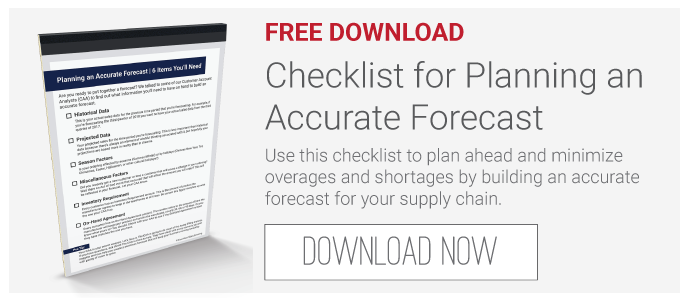Overseas manufacturing is challenging enough, and now more than ever we are seeing disruptions at nearly every stage of the process from availability of raw materials to logistical nightmares and port congestion. Not to mention the typical challenges related to distance, time zones, language barrier, cultural differences. And if forecasting falls onto your list of responsibilities, things right now are, well, challenging.

Forecasting is the art of knowing what you need before you need it. And by art, I mean it is a true skill born out of experience, intuition and, most of all, knowledge. But what do you need to know when you’re creating an accurate demand forecast? What data is needed? Are there tools you can use? Where do you start?
Let’s start with defining a demand forecast. The forecast is a document that plans and controls inventory. It’s used to order material or product from the supplier to the customer, typically making stops along the way at the factory and warehouse.
The forecast is built by the manufacturer customer service representative (CSR) taking a customer’s historical sales data and projected sales data and figuring out how much product the customer needs in stock, how much product needs to be in the warehouse, how much product needs to be in production at any given time.
It’s critically important for the CSR to look at their own records — how much has been ordered in the past — not just taking the customer’s word for it.
Here’s a hypothetical example:
Smart Company says it uses 500 pieces each month.
Armed with that information and knowing that the manufacturer needs to have three months of material on hand, Smart Company’s customer service representative stocks 1,500 pieces in the warehouse.
There’s just one problem. Smart Company overestimated their usage. They only use 200 pieces a month. That being the case, their manufacturer only needed to stock 600 pieces in the warehouse, and now they’re stuck holding an extra 900 pieces.
The inverse is just as bad. In fact, shortages might be even worse because it’s more difficult and expensive to get product to the customer on short notice. Air freight anyone?
But overages and shortages are both problems easily solved by building a correct forecast.
Best Practices for Accurate Forecasting
- Ask your Customer Account Rep what they need from you, then get it to them in a timely fashion.
- One of our most experienced customer account reps suggested looking at 12 months of sales data to get a realistic representation of your business — what you need to order, when you need to order it.
- No surprises. If you know something is coming — maybe you were interviewed by the New York Times for an upcoming story and you know orders are going to explode — tell your rep. They can help you plan accordingly. Likewise, if you just lost a customer and sales have slowed considerably, it’s a good idea to adjust your forecast.
- Accuracy > Frequency. A forecast that’s correct once a month is better than one that comes in wrong each week.
- Lead times. Be aware of your product’s lead time at all times and keep it in mind when making your forecast.
- If you’re not aware of what a big deal Chinese New Year is, we invite you to start reading all about it. Chinese New Year causes major disruption to the ordering cycle and your forecast and you need to always be thinking about how your order will be affected by the holiday. There are other Chinese holidays that are disruptive, too. Put them in your calendar now. Again, your rep will tell you the “order by” dates. Pay attention to the dates and take them to heart.
- Experience. Work with a supplier with experience in overseas shipping — especially if you don't have experience yourself.
- Ask questions. No one was born knowing how to forecast. I heard Zig Ziglar say that anything worth doing is worth doing poorly, until you learn to do it well. So learn how to forecast. You might do it poorly at first, but by asking questions and learning, you'll get better and better at it.
- Bottlenecks. Be aware of potential constraints or jams in the system. For example, the ports are jammed after the holidays because everything came to a standstill during the holidays. You have to factor that “recovery” time into your forecast.
Randy Strang, vice president of Global Program Management at UPS, spent the majority of his career designing and implementing global supply chain strategies. He knows a thing or two about forecasting and several years ago suggested manufacturers ask the following questions to improve their forecast accuracy. It would be worth asking these questions of yourself/your supplier:
- How consistent is your demand?
- What are the factors that influence the variable, or variables being forecast?
- What level of supply chain visibility do you have?
- How reliable are your modes of transport?
- Do you have access to multiple modes of transport?
If you're not using forecasting tools/software, there are plenty out there and all come with salespeople that are eager to tell you about them. We aren't going to make suggestions of specific brands or types of software to use other than to say, don't overbuy for your needs. Probably the best way to start looking for forecasting software is to ask people you know in your industry what they use, what they would recommend and what they like or don't like about it.
Look back at number 3 in the list of best practices. It says “Surprises.” In overseas shipping, surprises rarely mean something good has happened. “The only guaranteed in forecasting is that everything will not go exactly as planned,” Strang wrote. In our experience that’s true. The only thing a customer can do is to plan as best you can for every scenario, whether it seems likely or not. If you've got a good supplier, they'll have your back.
Ready to start pulling together the information you need to create your own forecast? Click on the download below for a free checklist to help you plan!





.jpg?width=176&height=56&name=MR_associatedNetwork_logo%20(1).jpg)